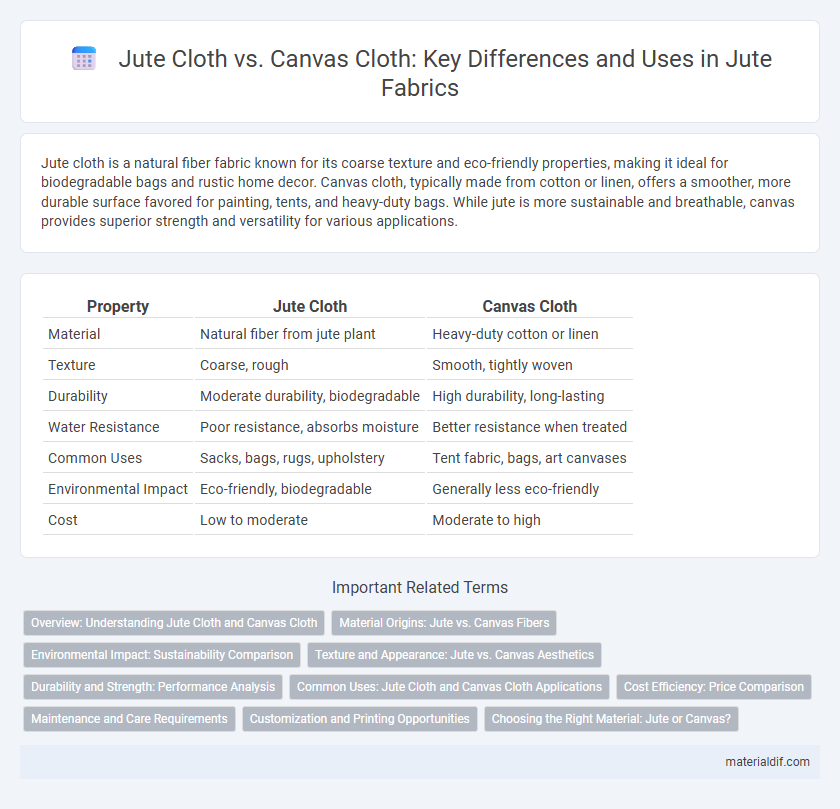Jute cloth is a natural fiber fabric known for its coarse texture and eco-friendly properties, making it ideal for biodegradable bags and rustic home decor. Canvas cloth, typically made from cotton or linen, offers a smoother, more durable surface favored for painting, tents, and heavy-duty bags. While jute is more sustainable and breathable, canvas provides superior strength and versatility for various applications.
Table of Comparison
| Property | Jute Cloth | Canvas Cloth |
|---|---|---|
| Material | Natural fiber from jute plant | Heavy-duty cotton or linen |
| Texture | Coarse, rough | Smooth, tightly woven |
| Durability | Moderate durability, biodegradable | High durability, long-lasting |
| Water Resistance | Poor resistance, absorbs moisture | Better resistance when treated |
| Common Uses | Sacks, bags, rugs, upholstery | Tent fabric, bags, art canvases |
| Environmental Impact | Eco-friendly, biodegradable | Generally less eco-friendly |
| Cost | Low to moderate | Moderate to high |
Overview: Understanding Jute Cloth and Canvas Cloth
Jute cloth, derived from the natural fiber of the jute plant, is renowned for its coarse texture, biodegradable nature, and affordability, often used in eco-friendly packaging and upholstery. Canvas cloth, made from cotton or linen fibers, offers a smoother, more durable surface ideal for painting, tents, and heavy-duty bags due to its tight weave and resilience. Understanding the distinct fiber sources, weaving techniques, and typical applications highlights the functional and environmental differences between jute cloth and canvas cloth.
Material Origins: Jute vs. Canvas Fibers
Jute cloth is derived from the natural fibers of the Corchorus plant, primarily grown in India and Bangladesh, making it a biodegradable and eco-friendly option. Canvas cloth, traditionally made from cotton or linen fibers, originates from woven plant-based materials that offer durability and strength ideal for heavy-duty use. The fiber composition of jute provides a coarse texture and breathability, while canvas fibers ensure a denser, sturdier fabric suitable for various industrial and artistic applications.
Environmental Impact: Sustainability Comparison
Jute cloth is highly sustainable due to its biodegradable fibers and minimal chemical use during cultivation, resulting in a lower carbon footprint compared to canvas cloth, which often relies on cotton that requires intensive water and pesticide use. Jute cultivation enriches the soil and consumes less water, promoting eco-friendly farming practices, whereas canvas production involves more resource-intensive processes that contribute to environmental degradation. Consequently, choosing jute cloth over canvas significantly reduces environmental impact and supports sustainable textile industries.
Texture and Appearance: Jute vs. Canvas Aesthetics
Jute cloth features a coarse, rough texture with natural earthy tones, giving it a rustic and organic appearance ideal for eco-friendly products. Canvas cloth, made from tightly woven cotton or linen fibers, exhibits a smooth, dense texture with a uniform surface, offering a clean and polished look suitable for artistic and durable applications. The contrasting textures and appearances make jute perfect for natural, rugged designs, while canvas excels in refined, versatile aesthetics.
Durability and Strength: Performance Analysis
Jute cloth exhibits moderate durability with a coarse texture suited for light to medium-duty applications, while canvas cloth demonstrates superior strength and resilience, making it ideal for heavy-duty uses such as tents and sails. Tensile tests reveal canvas's higher resistance to tearing and prolonged wear compared to jute. The inherent fiber composition of canvas, typically cotton or linen, contributes to its enhanced performance under stress versus the natural lignin content in jute that limits its durability.
Common Uses: Jute Cloth and Canvas Cloth Applications
Jute cloth is widely used for eco-friendly bags, sacks, and upholstery due to its biodegradable nature and coarse texture, ideal for storing agricultural products like grains and potatoes. Canvas cloth finds common applications in tents, sails, backpacks, and artist canvases because of its durability, water resistance, and heavier weight. Both fabrics serve versatile purposes in packaging, fashion, and home decor, yet jute emphasizes sustainability while canvas offers superior strength and weather resistance.
Cost Efficiency: Price Comparison
Jute cloth is significantly more cost-efficient than canvas cloth due to its lower raw material and production expenses, making it ideal for budget-conscious projects. While canvas is more durable and often preferred for heavy-duty applications, its higher price per yard reflects the cost of tightly woven cotton or synthetic fibers. Businesses targeting affordable and eco-friendly packaging or decor frequently choose jute because it balances functionality with lower overall expenditure.
Maintenance and Care Requirements
Jute cloth requires gentle handling and air drying to prevent fiber weakening and mold growth, while canvas cloth is more durable and can withstand frequent washing and vigorous scrubbing. Jute should be kept away from prolonged moisture exposure to avoid rotting, whereas canvas's cotton or synthetic fibers offer better resistance to moisture and mildew. Regular brushing or vacuuming helps maintain jute's texture, whereas canvas benefits from occasional machine washing without harsh detergents.
Customization and Printing Opportunities
Jute cloth offers limited customization and printing options due to its coarse texture and natural fibers, making intricate designs challenging to reproduce clearly. Canvas cloth, made from tightly woven cotton or linen, provides a smooth surface ideal for detailed prints and extensive customization, including vibrant colors and complex artwork. Custom printing on canvas is favored for promotional materials and art projects where precision and color fidelity are essential.
Choosing the Right Material: Jute or Canvas?
Jute cloth offers natural biodegradability and breathability, making it ideal for eco-friendly packaging and lightweight applications, while canvas cloth provides superior durability and water resistance, suitable for heavy-duty uses such as bags and outdoor gear. Jute fibers create a coarse texture that enhances rustic aesthetics, whereas canvas, typically made from cotton or hemp, ensures a smoother and stronger fabric surface. Choosing between jute and canvas depends on whether sustainability and lightness or strength and longevity are prioritized for the specific project.
Jute Cloth vs Canvas Cloth Infographic

 materialdif.com
materialdif.com